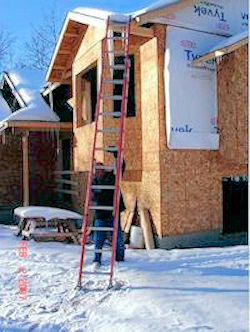Real-Life Scenario
A carpenter was injured when he fell from a ladder that slipped away from the drip edge of a house.
The victim positioned the fiberglass extension ladder diagonally across the inside corner of the roof to secure a 2-inch by 4-inch piece of wood to the fascia under the drip edge to protect the drip edge.
The ladder's safety feet were in an up position on the frozen soil. He called to his coworker to hold the ladder while he accessed the roof area. A coworker stood underneath the ladder and held rung #5 with his right hand and rung #7 with his left hand.
The victim climbed the ladder holding the wood, at rung #8 and #9 when the base of the ladder slipped away from the house. When the ladder fell, it struck the coworker on his shoulder and arm and knocked him to the ground.
The victim fell from the ladder and landed on his back. Emergency crews transported the victim to the hospital where he died six days later.
CDC Recommendations:
1. Employers should ensure that ladders are used in accordance with the requirements of existing safety standards and good standard practice.
2. Employers should develop and implement a comprehensive written safety program.
3. Construction employers should conduct a daily hazard assessment to determine if environmental working conditions have changed or will change. They should inform their employees of their findings and how the changing conditions may affect the work to be performed.
4. Employers should consider having at least one person on the jobsite certified in First Aid/CPR, should strongly consider having an individual certified as a Medical First Responder or Emergency Medical Technician (EMT), and hold at least semi-annual workplace rescue/first aid practices.
Knowledge Check Choose the best answer for the question.
2-7. To make sure ladders are being used correctly on the construction worksite, what action should be taken?
You forgot to answer the question!

